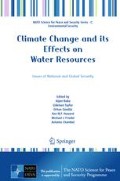Abstract
This paper introduces a novel method for controlling of the cyanobacteria concentration in open water reservoirs during periods of global warming. The technology is based on usage of nanophotocatalysts made from nanocarbon-metal composition with titanium as the metal. Under the natural ultraviolet radiation, the nanophotocatalysts form OH-radicals in water that destroy cyanobacteria. Field tests in natural water revealed it to be efficient with low consumption of nanocompositions (about 10 g/ha or 50 l of aqueous solution of the nanocomposition with the concentration of 200 mg/l), OH-radicals formed only in the upper water layers where cyanobacteria grow, and nanocompositions coagulate and precipitate harmless water-insoluble particles within the first day.
Access this chapter
Tax calculation will be finalised at checkout
Purchases are for personal use only
References
Walther GR, Post E, Convey P, Menzel A, Parmesan C, Beebee TJC, Fromentin JM, Hoegh-Guldberg O, Bairlein F (2002) Ecological responses to recent climate change. Nature 416:389–395
Treydte KS, Schleser GH, Helle G, Frank DC, Winiger M, Haug GH, Esper J (2006) The twentieth century was the wettest period in northern Pakistan over the past millennium. Nature 440:1179–1182
Prospero JM, Lamb PJ (2003) African droughts and dust transport to the Caribbean: climate change implications. Science 302:1024–1027
Webster PJ, Holland GJ, Curry JA, Chang HR (2005) Changes in tropical cyclone number, duration, and intensity in a warming environment. Science 309:1844–1846
Paerl HW, Bland PT, Bowles ND, Haibach ME (1985) Adaptation to high intensity, low wavelength light among surface blooms of the cyanobacterium Microcystis aeruginosa. Appl Environ Microbiol 49:1046–1052
Robarts RD, Zohary T (1987) Temperature effects on photosynthetic capacity, respiration, and growth rates of bloom-forming cyanobacteria. Freshwater Res 21:391–399
Murrell MC, Lores EM (2004) Phytoplankton and zooplankton seasonal dynamics in a subtropical estuary: importance of cyanobacteria. J Plankton Res 26:371–382
Castenholz RW, Garcia-Pichel F (2000) Cyanobacterial responses to UV radiation. In: Whitton BA, Potts M (eds) The ecology of cyanobacteria. Kluwer, Dordrecht, pp 591–611
He Y-Y, Klisch M, Häder D-P (2002) Adaptation of cyanobacteria to UV-B stress correlated with oxidative stress and oxidative damage. Photochem Photobiol 76:188–196
Xue L, Zhang Y, Zhang T, An L, Wang X (2005) Effects of enhanced ultraviolet- B radiation on algae and cyanobacteria. Crit Rev Microbiol 31:79–89
Chorus I (2001) Cyanotoxins: occurrence, causes, consequences. Springer, Berlin, p 357
Carmichael WW, Falconer IR (1993) Diseases related to freshwater blue-green algal toxins, and control measures. In: Falconer IR (ed) Algal toxins in seafood and drinking water. Academic, London, pp 187–209
Falconer IR, Beresford AM, Runnegar MT (1983) Evidence of liver damage by toxin from a bloom of blue-green algae, Microcystis aeruginosa. Med J 1:511–514
Hawkins PR, Chandrasena NR, Jones GJ, Humpage AR, Falconer IR (1997) Isolation and toxicity of Cylindrospermopsis raciborskii from an ornamental lake. Toxicon 35:341–346
Humpage AR, Hardy SJ, Moore EJ, Froscio SM, Falconer IR (2000) Microcystins (cyanobacterial toxins) in drinking water enhance the growth of aberrant crypt foci in the mouse colon. J Toxicol Environ Health 61:155–165
Kirpenko YA, Sirenko LA, Kirpenko NI (1981) Some aspects concerning remote after-effects of blue-green algal toxin impact on warm-blooded animals. In: Carmichael WW (ed) The water environment, algal toxins and health. Plenum, New York, pp 257–269
Soong FS, Maynard E, Kirke K, Luke C (1992) Illness associated with blue-green algae. Med J Aust 156:67
Turner PC, Gammie AJ, Hollinrake K, Codd GA (1990) Pneumonia associated with contact with cyanobacteria. Br Med J 300:1440–1441
Spolaore P, Joannis-Cassan C, Duran E, Isambert A (2006) Commercial applications of microalgae. J Biosci Bioeng 101(2):87–96
Bryan CS, Michael OW (2005), Metal nanoparticle – conjugated polymer nanocomposites. Chem Commun 27:3375–3384
Daniel MC, Astruc D (2004) Gold nanoparticles: assembly, supramolecular chemistry, quantum-size-related properties, and applications toward biology, catalysis, and nanotechnology. Chem Rev 104:293–346
Khlebtsov NG, Trachuk LA, Mel’nikov AG (2005) Sensitivity of metal nanoparticle surface plasmon resonance to the dielectric environment. Opt Spectrosk 98:77–86
Mock JJ, Smith DR, Schultz S (2003) Interparticle coupling effects on plasmon resonances of nanogold particles. Nano Lett 3:1087–1090
Mulvaney P (2001) Not all that’s gold does glitter. MRS Bull 26:1009–1014
Murphy CJ, Jana NR (2002) Controlling the aspect ratio of inorganic nanorods and nanowires. Adv Mater 14:80–82
Rao CNR, Cheetham AK (2001) Science and technology of nanomaterials: current status and future prospects. J Mater Chem 11:2887–2894
Schmid G, Simon U (2005) Gold nanoparticles: assembly and electrical properties in 1–3 dimensions. Chem Commun 6:697–710
Tan Y, Li Y, Zhu D (2003) Synthesis of poly (2-methoxyaniline)/Au nanoparticles in aqueous solution with chlorauric acid as the oxidant. Synth Met 847:135–136
Doohyun K, Yujin H, Seong IR, Cheong J, Keun Lee D, Hong SM, Lee JE, Kim SH (2005) Production and characterization of carbon nano colloid via one-step electrochemical method. J Nanopart Res 10(7):1121–1128
Hsu WK, Terrones M, Hare JP, Terrones H, Kroto HW, Walton DRM (1996) Electrolytic formation of carbon nanostructures. Chem Phys Lett 262:161–166
Khaydarov RR, Khaydarov RA, Gapurova O (2009) Remediation of contaminated groundwater using nano-carbon colloids. In: Igor Linkov, Jeffery Steevens (eds) Nanomaterials: risk and benefits, NATO science for peace and security series c: environmental security. Springer, Dordrecht, pp 219–224
Peckett JW, Trens P, Gougeon RD, Poppl A, Harris RK, Hudson MJ (2000) Electrochemically oxidised graphite-characterisation and some ion exchange properties. Carbon 38:345–353
Khaydarov RA, Khaydarov RR, Gapurova O (2010) Water purification from metal ions using carbon nanoparticle-conjugated polymer nanocomposites. Water Res 44(6):1927–1933
Author information
Authors and Affiliations
Corresponding author
Editor information
Editors and Affiliations
Rights and permissions
Copyright information
© 2011 Springer Science+Business Media B.V.
About this paper
Cite this paper
Khaydarov, R.A., Khaydarov, R.R., Gapurova, O. (2011). Regulation of Cyanobacteria in Large Open Water Reservoirs. In: Baba, A., Tayfur, G., Gündüz, O., Howard, K., Friedel, M., Chambel, A. (eds) Climate Change and its Effects on Water Resources. NATO Science for Peace and Security Series C: Environmental Security, vol 3. Springer, Dordrecht. https://doi.org/10.1007/978-94-007-1143-3_17
Download citation
DOI: https://doi.org/10.1007/978-94-007-1143-3_17
Published:
Publisher Name: Springer, Dordrecht
Print ISBN: 978-94-007-1142-6
Online ISBN: 978-94-007-1143-3
eBook Packages: Earth and Environmental ScienceEarth and Environmental Science (R0)

